 Image search results - "kanagawa," Image search results - "kanagawa," |

From late April to early May, five long strings of giant carp streamers swim in the air high above the Sagami River in Sagamihara, Kanagawa. This event was started in 1988.
|
|

There are five rows of streamers. In Japan, the koi carp is regarded as a symbol of valiant manhood because it swims up the river against the rapids.
|
|

The cable length is 250 meters and 13mmm thick. There are about 1,200 carp streamers. They are reused every year and donated by local families. (I also noticed a few advertising carps.)
|
|
|
|
|

Sagami River Koi-nobori
|
|
|
|
|
|

The longest carp is 10 meters.
|
|
|

Along the river were food stalls.
|
|

Festival site
|
|

Cable anchor
|
|
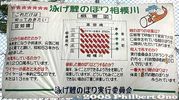
Statistics
|
|

Hiking around the island (not recommended). There is a nice path going around half the island. But the other half lacks a real path. It is somewhat risky.
|
|

Cave at Enoshima
|
|

Other side of the island
|
|
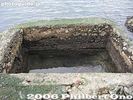
Fishing hole
|
|
|
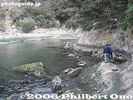
Rough trail
|
|

Finally back to civilization
|
|

The festival is actually held from the first to second Sunday in July. Eighth day is the main day.The festival procession comes toward Enoshima's gateway which is the Seido no Torii (青銅の鳥居) gate.
This day-long festival starts at 9:30 am at Enoshima's Hetsunomiya Shrine. A large mikoshi (portable shrine) from Yasaka Shrine is carried from the shrine to Koyuguri Shrine on the mainland. Along the way, the mikoshi is carried into the ocean. On the mainland, the Yasaka mikoshi is met with a mikoshi from Koyuguri Shrine. They then parade together along a shopping street before the Yasaka mikoshi goes back to Enoshima at around 6 pm.
|
|
|

Tengu manIn the searing heat of summer, this costume must be unbearable.
|
|
|

Preparing for the seaDuring a break, the mikoshi is prepared for a run in the ocean.
|
|
|
|
|
|
|
|
|
|

Water's edge
|
|

Down ramp
|
|
|

At seaShrine helpers on a boat splash buckets of sea water on the mikoshi bearers.
|
|

Blessings at seaThe mikoshi and bearers are blessed by a shrine priest on a boat wielding a sacred staff.
|
|
|
|
|
|
|
|
|
|
|

Mikoshi made of acorns
|
|

Crossing over
|
|
|
|
|

Passing Enoshima Station
|
|

Passing by Ryukoji Temple
|
|

Mikoshi face-offThe shrine from Yasaka Shrine on Enoshima is the male (left), and the mikoshi from Koyurugi Shrine (foreground) is female.
|
|

Tram breakPart of the procession route also happened to be the Enoden streetcar route so we had to make way for the passing streetcar every 15 min. or so. There were streetcar personnel who blew their loud whistles whenever a streetcar was to pass through. I got scolded for sticking out my head to take this shot.
|
|
|

Streetcar break
|
|

Entrance to Koyurugi ShrineIt is dedicated to the sea goddess.
|
|

Secondary shrines
|
|

Koyurugi Shrine lookoutThe shrine is built atop a cliff overlooking the ocean, and there's small lookout offering sweeping view with Enoshima in the distance.
|
|

Koyurugi Shrine
|
|

Parading along a shopping street
|
|
|
|

KnockersWhen they carry the mikoshi, a pair of knockers on both sides the mikoshi are struck to make a rhythmic sound.
|
|
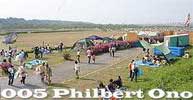
The following photos were taken on May 5, 2005. The site is on a baseball field, very dusty. The site is directly south and downstream from the Sagamihara kite festival site.It was a great idea to hold both kite festivals on the same days. We could see both in one day.
|
|
|
|
|
|

Corner rope work
|
|
|
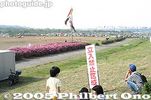
Do not enter sign. In 2004, on a very windy day (almost typhoon strength), Zama's giant kite broke in the air and crashed to the ground onto spectators (who got hurt) on the side, right beyond the carp streamers in this picture. So from 2005, they have become very strict and cordoned off the area where the kite crashed.
|
|

Ready and all clear
|
|
|

Lift off despite weak winds
|
|
|
|
|
|
|
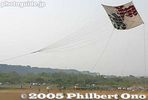
Zama's kite apparently was lighter than Sagamihara's kite because it went up much higher under the same wind conditions.
|
|

The kite pullers can only run so far (about 50 meters or so). After that, if the wind doesn't kick in, the kite falls back down.
|
|
|

Rope anchor
|
|

Rope anchor
|
|

Entertaiment
|
|
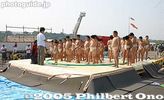
Children's sumo. Zama had a variety of side events.
|
|

Disassembly
|
|
|
|
|
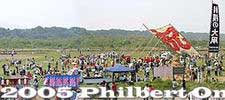
Sagami Giant Kite festival is held annually on May 4 and 5 along the Sagami River bank. The site is near JR Sobudaishita (相武台下) on the JR Sagami Line.
|
|

Lean-to shade.
|
|
|
|

Rear view
|
|

Entertainment during Sagami Giant Kite Festival
|
|

Take off of a smaller kite
|
|
|
|
|

Take off of another smaller kite
|
|
|
|
|
|

Successful flight
|
|

Anchor
|
|

Preparing the big one.
|
|
|
|

Bamboo poles used to prop up the giant kite.
|
|

Moving the giant kite to launch site
|
|
|
|

Spectators watch along the side and rear.
|
|
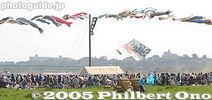
Sagamihara city is adjacent to Zama city which also held their own giant kite festival on the same day adjacent to Sagamihara's site. This is a launch of Zama's giant kite which soon went back to the ground due to inadequate winds.
|
|

The site is cleared of people before the launch.
|
|

Inadequate winds. The kite struggles to lift off.
|
|

The kite went back down almost immediately after hovering a few feet above ground.
|
|
|
|
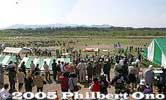
Panorama of festival site.
|
|
|

Preparing the giant kite
|
|
|
|
|
|

Moving the kite to launch point
|
|
|
|
|

Kite pullers
|
|
|

And we have lift off!
|
|
|

TakoKites in the shape of an octopus is common because the Japanese word for kite is "tako" which is the same pronunciation for the word octopus in Japanese.
|
|

Guest kite from Yokaichi, Shiga PrefectureThis is a smaller version of their giant kite. Yokaichi (Higashi Omi) also holds a giant kite festival in May.
|
|

Yokaichi's anchor truck
|
|

Beautiful lavendar
|
|
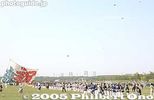
Another launchThey fly the kite a few times during the festival days.
|
|
|
|
|
|
|
|

Rope anchor
|
|
|

DisassemblyThe paper is actually large strips that can be removed and rolled up.
|
|
|
|
|
|
|
|
|
|